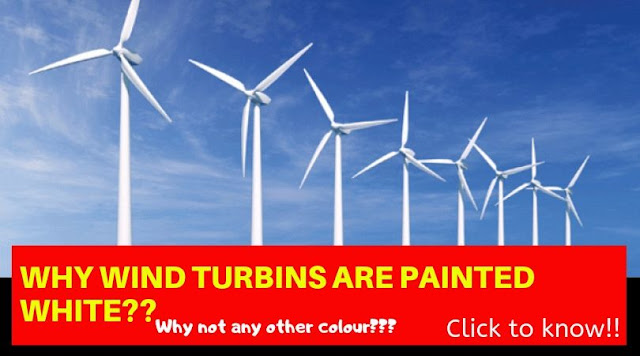You might have noticed that almost every wind turbine is painted white in colour.We will discuss reasons behind the white colour in this article.
1.)Generally wind turbines are painted white to be more aesthetically pleasing than otherwise. Painting them white or light grey helps the entire structure "blend" into the background, especially when the sky is cloudy. By making the entire structure white, the wind turbine is less visually obtrusive, in theory at least. White, after all, is a pretty neutral color.
2.)White, with an absence of colour, reflects sunlight and therefore reflect heat. Heat causes expansion, drying up of lubrication, and blistering. Consequently any colour would either shorten the life of a wind turbine by introducing increased wear and tear, or be more expensive in terms of maintenance.
3.)Third reason is to make them visible from the sky.From the sky looking down, planes and aircraft will be able to see them standing out in the grass below them. This rule was implemented for safety reasons, and it is actually required by law that pilots must have a clear view of all wind turbines from above to avoid any accidents. So these are the basic reasons why wind turbines are painted in white colour.If you liked this article then share it with your friends and if you have any doubt then feel free to ask in comment section.
Stronger than steel and a fraction of the weight, carbon fiber is a brilliant invention. Since its first use as a motor case on space rockets in the 1960s, it's often proclaimed as the ticket to better performance. It costs enough that it better. Despite 50 years of advancements carbon fibre remains expensively high end. But 50 years later, carbon fiber is still rare and expensive (starting at $10/pound.The rate of steel is $0.38/pound.)
FEW FACTS ABOUT CARBON FIBER:
1.)Carbon fiber -- sometimes known as graphite fiber -- is a strong, stiff, lightweight material that has the potential to replace steel and is popularly used in specialized, high-performance products like aircrafts, racecars and sporting equipment.2.)The next generation of carbon-fiber composites could reduce passenger car weight by 50 percent and improve fuel efficiency by about 35 percent without compromising performance or safety.
3.)Carbon fiber can be woven into a fabric that is suitable for use in defense applications or added to a resin and molded into preformed pieces, such as vehicle components or wind turbine blades.WHY CARBON FIBER IS EXPENSIVE:
The main reason for high cost of carbon fiber is its manufacturing process.Let us see how it is made and what makes it expensive.
Before carbon fiber becomes carbon fiber, it starts as a base material—usually an organic polymer with carbon atoms binding together long strings of molecules called a polyacrylonitrile(similar to the acrylics in sweaters and carpets).To get the carbon part of carbon fiber, half of the starting material's acrylic needs to be removed. "The final product will cost double what you started with because half burns off,"This is responsible for a big part of the costs.Then there are two major processing steps. The first is called oxidization stabilization. Here the fibers are fed through very long ovens with temperatures of several hundred degrees. The process takes hours to complete and is therefore a massive energy eater.
The second step is carbonization where the material is again placed in an oven, but this time the temperatures rise over thousand degrees. This step will also increase the power bill. It doesn’t end there.
Manufactures also have to take care of the off-gases to make sure they do not poison the environment, which needs lot’s of energy, real estate and large equipment. All steps are just for the manufacturing of the individual filaments themselves.To get to the final product, the fibers and the resin have to be shaped and cured in an autoclave, again a time and energy consuming process.
So,the process of manufacturing is time taking and energy eating also only half of the raw material is used in final product.This leads to the high cost of carbon fibre.
1.)AIR GATE – A vertical channel for the removal of gases from the mould;
checking of the filling of the mould cavity with metal and feeding up
the casting with metal during solidification.
2.)BACK DRAFT – Taper or draft which prevents removal of pattern from the
mould.
3.)BINDER – Material used to hold the grains of sand together in moulds or
cores. May be cereal, oil, clay, resin, pitch etc.
4.)BLEED – Molten metal oozing out of a casting stripped or removed from
the mould before solidification.
5.)CAVITY, MOULD or DIE – Impression or impressions in a mould or die
that give the casting its shape.
6.)CHILL – A metal object placed on the outside or inside a mould cavity to
induce more rapid cooling at that point and thereby produce hard zone
i.e., hard, unmachinable surface.
7.)COPE – The upper or top most section of a flask, mould or pattern.
8.)DRAFT – Taper allowed on the vertical faces of a pattern to permit removal
of it from the sand mould without excessive rapping or tearing of the
mould walls.
9)DRAG – The lower or bottom section of a mould or pattern.
10.)FLASH – Thin fin or web of metal extending from the casting along the
joint line as a result of poor contact between cope and drag moulds.








